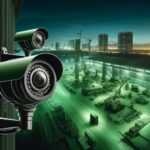Surveillance cameras have become an integral part of modern security systems, providing businesses and individuals with an effective means of monitoring and protecting their properties. It allows you to monitor or record activity in and around an area for many different reasons. Let’s review the technical aspects of how surveillance cameras work, and the benefits they offer for businesses. By understanding the inner workings of these devices, you can make informed decisions when it comes to implementing a surveillance system for your business with the help of professionals.
The Basic Components of a Surveillance Camera
At the core of every surveillance camera are several key components that enable it to capture, process, and transmit video footage. These include:
- Image sensor: The image sensor is responsible for converting light into an electrical signal. The two most common types of image sensors are CCD (Charged Coupled Device) and CMOS (Complementary Metal-Oxide Semiconductor).
- Lens: The lens focuses light onto the image sensor, determining the camera’s field of view and the level of detail captured.
- Processor: The processor handles the digital processing of the captured image, including compression, noise reduction, and color correction.
- Storage: Surveillance cameras often feature built-in storage, such as an SD card or internal memory, to save recorded footage locally.
- Network interface: For IP cameras, a network interface allows the camera to connect to a local network and transmit video data over the internet.
How Surveillance Cameras Capture and Process Video
When light enters the lens of a surveillance camera, it is focused onto the image sensor, which consists of a grid of light-sensitive pixels. Each pixel generates an electrical charge proportional to the amount of light it receives. The image sensor then converts these charges into a digital signal, which is processed by the camera’s internal circuitry.
The processor applies various algorithms to enhance the image quality, such as noise reduction, sharpening, and color correction. The processed video is then compressed using codecs like H.264 or H.265 to reduce the file size and make it more efficient for storage and transmission.
Types of Surveillance Cameras
There are several types of surveillance cameras available, each with its own unique features and benefits:
- Analog cameras: These traditional cameras transmit video signals over coaxial cables to a digital video recorder (DVR) for storage and viewing.
- IP cameras: Internet Protocol (IP) cameras encode video and transmit it over a local network or the internet, allowing for remote access and flexible installation.
- Wireless cameras: These cameras use Wi-Fi to connect to a network, eliminating the need for physical cables and making installation easier.
- PTZ cameras: Pan-Tilt-Zoom (PTZ) cameras can be remotely controlled to adjust their viewing angle and zoom level, providing greater flexibility in monitoring large areas.
Benefits of Surveillance Cameras for Businesses
Implementing a surveillance camera system offers numerous benefits for businesses, including:
- Deterrence: The presence of visible cameras can deter potential criminals, reducing the likelihood of theft, vandalism, and other illegal activities.
- Evidence gathering: In the event of an incident, recorded footage can serve as valuable evidence for law enforcement and insurance purposes.
- Remote monitoring: IP cameras allow business owners and security personnel to monitor premises remotely, enabling quick response times to potential threats.
- Employee productivity: Surveillance cameras can help ensure that employees are following proper protocols and maintaining productivity.
- Liability protection: Video evidence can help protect businesses from false liability claims, such as slip-and-fall accidents or workplace disputes.
Choosing the Right Surveillance Camera System
When selecting a surveillance camera system for your business, consider the following factors:
- Coverage area: Determine the size and layout of the area you need to monitor, and choose cameras with appropriate fields of view and ranges.
- Image quality: Opt for cameras with high resolution and low-light performance to ensure clear, detailed footage in various lighting conditions.
- Storage capacity: Consider the amount of storage you’ll need for recorded footage, and choose a system with sufficient capacity and backup options.
- Network infrastructure: For IP cameras, ensure that your network can handle the bandwidth requirements and provide adequate security measures.
- Scalability: Choose a system that can easily expand to accommodate future growth and changing security needs.
Advancements in Surveillance Camera Technology
As technology continues to evolve, surveillance cameras are becoming increasingly sophisticated, offering new features and capabilities:
- AI and analytics: Advanced cameras can now utilize artificial intelligence and video analytics to detect and classify objects, recognize faces, and alert operators to potential threats.
- Cloud storage: Cloud-based storage solutions provide scalable, off-site backup for recorded footage, reducing the risk of data loss due to hardware failure or physical damage.
- Integration with other systems: Surveillance cameras can be integrated with access control, intrusion detection, and other security systems to create a comprehensive, centralized security solution.
- High-resolution and panoramic views: The advent of 4K and multi-sensor cameras enables ultra-high-resolution imaging and wide-area coverage, providing even greater detail and situational awareness.
Legal Considerations and Best Practices
When implementing a surveillance camera system, it’s crucial to understand and adhere to local laws and regulations regarding privacy and data protection. Some key considerations include:
- Obtaining necessary permits and licenses for installation and operation.
- Posting clear signage to inform individuals that they are being recorded.
- Securing recorded footage and limiting access to authorized personnel only.
- Regularly reviewing and updating your surveillance camera policy to ensure compliance with evolving laws and best practices.
The Importance of Proper Surveillance Camera Placement
Effective surveillance camera placement is essential for maximizing coverage, minimizing blind spots, and ensuring the capture of high-quality footage. When positioning your cameras, keep these tips in mind:
- Identify high-risk areas: Prioritize camera placement in areas with a higher likelihood of incidents, such as entry and exit points, cash registers, and valuable inventory storage.
- Consider lighting conditions: Ensure that cameras are placed in well-lit areas or equipped with infrared illuminators for low-light environments.
- Avoid obstructions: Position cameras to minimize obstructions from objects like trees, poles, or signs that could block the view or create blind spots.
- Adhere to legal requirements: Ensure that camera placement complies with local laws and regulations, particularly in areas where there is a reasonable expectation of privacy.
Maintaining and Upgrading Your Surveillance Camera System
Regular maintenance and timely upgrades are crucial for ensuring the ongoing effectiveness and reliability of your surveillance camera system. Key maintenance tasks include:
- Cleaning camera lenses and housings to maintain image quality and protect against environmental damage.
- Checking camera alignments and adjusting as necessary to maintain proper coverage.
- Testing and replacing storage devices, such as hard drives or SD cards, to prevent data loss.
- Updating camera firmware and VMS software to access the latest features, bug fixes, and security patches.
Contact Live Patrol to Learn More About How Surveillance Cameras Work
If you’re interested in learning more about how surveillance cameras work and how they can benefit your business, contact Live Patrol today. Our team of experienced security professionals can provide expert guidance on selecting and installing the right surveillance camera system for your company. We offer a range of cutting-edge solutions, from high-resolution IP cameras to AI-powered analytics, backed by exceptional customer support and technical expertise.


